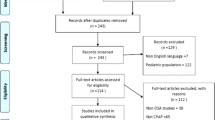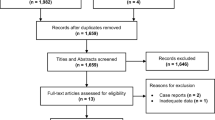Abstract
Purpose
An earlier study found that heated humidification reduced the side effects of positive airway pressure (PAP) in patients with obstructive sleep apnoea (OSA). However, other studies disagreed with this finding. Therefore, we evaluated the relationship between heated humidification and the side effects of PAP in patients with OSA.
Methods
According to the Preferred Reporting Items for Systematic Reviews and Meta-Analyses guidelines, six databases were searched for relevant randomised controlled trials (RCTs) performed from January 1999 to June 2021.
Results
From 1012 retrieved articles, we identified 9 eligible RCTs. Compared to the control group, the heated humidification group reported improvements in dry nose (pooled standardised mean difference [SMD] = − 0.70, 95% confidence interval [CI] = − 0.96 to − 0.45, I2 = 0%, p < 0.00001), blocked nose (SMD = − 0.47, 95%CI − 0.69 to − 0.25, I2 = 36%, p < 0.0001), runny nose (SMD = − 0.22, 95%CI − 0.44 to 0, I2 = 0%, p = 0.05), dry mouth (SMD = − 0.62, 95%CI − 0.87 to − 0.37, I2 = 0%, p < 0.00001), and dry throat (SMD = − 0.61, 95%CI − 0.90 to − 0.33, I2 = 41%, p < 0.0001), but did not enhance positive airway pressure adherence (pooled mean difference [MD] = 0.24, 95% CI − 0.10 to 0.58, I2 = 0%, p = 0.17).
Conclusions
Heated humidification improved some PAP side effects in patients with OSA but did not increase PAP adherence. Additional large-scale multi-centre RCTs are needed to verify the long-term effects.








Similar content being viewed by others
References
Veasey SC, Rosen IM (2019) Obstructive Sleep Apnea in Adults. N Engl J Med 380(15):1442–1449
Gileles-Hillel A, Kheirandish-Gozal L, Gozal D (2016) Biological plausibility linking sleep apnoea and metabolic dysfunction. Nat Rev Endocrinol 12(5):290–298
Leng Y, McEvoy CT, Allen IE et al (2017) Association of sleep-disordered breathing with cognitive function and risk of cognitive impairment: a systematic review and meta-analysis. JAMA Neurol 74(10):1237–1245
Floras JS (2018) Sleep apnea and cardiovascular disease: an enigmatic risk factor. Circ Res 122(12):1741–1764
Peppard PE, Young T, Barnet JH et al (2013) Increased prevalence of sleep-disordered breathing in adults. Am J Epidemiol 177(9):1006–1014
Watson NF (2016) Health care savings: the economic value of diagnostic and therapeutic care for obstructive sleep apnea. Clin Sleep Med 12(8):1075–1077
Spicuzza L, Caruso D, Di Maria G (2015) Obstructive sleep apnoea syndrome and its management. Ther Adv Chronic Dis 6(5):273–285
Kribbs NB, Pack AI, Kline LR et al (1993) Objective measurement of patterns of nasal CPAP use by patients with obstructive sleep apnea. Am Rev Respir Dis 147(4):887–895
Sutherland K, Kairaitis K, Yee BJ et al (2018) From CPAP to tailored therapy for obstructive sleep Apnoea. Multidiscip Respir Med 13:44
Galetke W, Puzzo L, Priegnitz C et al (2011) Long-term therapy with continuous positive airway pressure in obstructive sleep apnea: adherence, side effects and predictors of withdrawal- a ’real-life’ study. Respiration 82:155–161
Ulander M, Johansson MS, Ewaldh AE et al (2014) Side effects to continuous positive airway pressure treatment for obstructive sleep apnoea: changes over time and association to adherence. Sleep Breath 18(4):799–807
Park P, Kim J, Song YJ et al (2017) Influencing factors on CPAP adherence and anatomic characteristics of upper airway in OSA subjects. Medicine 96:e8818
Ghrairi H, Khalfallah I, Abid N et al (2018) Adherence to treatment with continuous positive airways pressure. Rev Mal Respir 35:531–537
Stepnowsky CJ, Marler MR, Palau J et al (2006) Social-cognitive correlates of CPAP adherence in experienced users. Sleep Med 7(4):350–356
Pepin JL, Leger P, Veale D et al (1995) Side effects of nasal continuous positive airway pressure in sleep apnea syndrome. Study of 193 patients in two French sleep centers. Chest 107:375–81
Broström A, Arestedt KF, Nilsen P et al (2010) The side-effects to CPAP treatment inventory: the development and initial validation of a new tool for the measurement of side-effects to CPAP treatment. J Sleep Res 19(4):603–611
Ghadiri M, Grunstein RR (2020) Clinical side effects of continuous positive airway pressure in patients with obstructive sleep apnoea. Respirology 25(6):593–602
Patil SP, Ayappa IA, Caples SM et al (2019) Treatment of adult obstructive sleep apnea with positive airway pressure: an American academy of sleep medicine systematic review, meta-analysis, and GRADE Assessment. J Clin Sleep Med 15(2):301–334
Koutsourelakis I, Vagiakis E, Perraki E et al (2011) Nasal inflammation in sleep apnoea patients using CPAP and effect of heated Humidify-cation. Eur Respir J 37(3):587–594
Neill AM, Wai HS, Bannan SP et al (2003) Humidified nasal continuous positive airway pressure in obstructive sleep apnoea. Eur Respir J 22(2):258–262
Ruhle KH, Franke KJ, Domanski U et al (2011) Quality of life, compliance, sleep and nasopharyngeal side effects during CPAP therapy with and without controlled heated humidification. Sleep Breath 15(3):479–485
Ryan S, Doherty LS, Nolan GM et al (2009) Effects of heated humidification and topical steroids on compliance, nasal symptoms, and quality of life in patients with obstructive sleep apnea syndrome using nasal continuous positive airway pressure. J Clin Sleep Med 5(5):422–427
Duong M, Jayaram L, Camfferman D et al (2005) Use of heated humidification during nasal CPAP titration in obstructive sleep apnoea syndrome. Eur Respir J 26(4):679–685
Wiest GH, Harsch IA, Fuchs FS et al (2002) Initiation of CPAP therapy for OSA: does prophylactic humidification during CPAP pressure titration improve initial patient acceptance and comfort? Respiration 69(5):406–412
Page MJ, Moher D, Bossuyt PM et al (2021) PRISMA 2020 explanation and elaboration: updated guidance and exemplars for reporting systematic reviews. BMJ. 372:n160
Higgins JP, Altman DG, Gøtzsche PC et al (2011) The Cochrane Collaboration’s tool for assessing risk of bias in randomised trials. BMJ. 343:d5928
Mador MJ, Krauza M, Pervez A et al (2005) Effect of heated humidification on compliance and quality of life in patients with sleep apnea using nasal continuous positive airway pressure. Chest 128(4):2151–2158
Massie CA, Hart RW, Peralez K et al (1999) Effects of humidification on nasal symptoms and compliance in sleep apnea patients using continuous positive airway pressure. Chest 116(2):403–408
Salgado SM, Boleo-Tome JP, Canhao CM et al (2008) Impact of heated humidification with automatic positive airway pressure in obstructive sleep apnea therapy. J Bras Pneumol 34(9):690–694
Worsnop CJ, Miseski S, Rochford PD (2010) Routine use of humidification with nasal continuous positive airway pressure. Intern Med J 40(9):650–656
Soudorn C, Muntham D, Reutrakul S et al (2016) Effect of heated humidification on CPAP therapy adherence in subjects with obstructive sleep apnea with nasopharyngeal symptoms. Respir Care 61(9):1151–1159
Nilius G, Franke KJ, Domanski U et al (2016) Effect of APAP and heated humidification with a heated breathing tube on adherence, quality of life, and nasopharyngeal complaints. Sleep Breath 20(1):43–49
Koutsourelakis I, Vagiakis E, Perraki E et al (2011) Nasal inflammation in sleep apnoea patients using CPAP and effect of heated humidification. Eur Respir J 37(3):587–594
Richards GN, Cistulli PA, Ungar RG et al (1996) Mouth leak with nasal continuous positive airway pressure increases nasal airway resistance. Am J Respir Crit Care Med 154(1):182–186
Hayes MJ, McGregor FB, Roberts DN et al (1995) Continuous nasal positive airway pressure with a mouth leak: effect on nasal mucosal blood flux and nasal geometry. Thorax 50(11):1179–1182
Cruz AA, Naclerio RM, Proud D et al (2006) Epithelial shedding is associated with nasal reactions to cold, dry air. J Allergy Clin Immunol 117(6):1351–1358
Shapiro GK, Shapiro CM (2010) Factors that influence CPAP adherence: an overview. Sleep & Breathing 14(4):323–335
Victor LD (2004) Treatment of obstructive sleep apnea in primary care. Am Fam Physician 69(3):561–568
Weaver TE (2006) Adherence to positive airway pressure therapy. Current Opinion in Pulmonary Medicicne 12(6):409–413
Chhajed PN, Chhajed TP, Tamm M et al (2004) Obstructive sleep apnea: therapies other than CPAP. J Assoc Physicians India 52:143–151
Means MK, Edinger JD (2007) Graded exposure therapy for addressing claustrop-hobic reactions to continuous positive airway pressure: a case series report. Behav Sleep Med 5:105–116
Chinese Medical Association, Chinese Medical Journals Publishing House, Chinese Society of General Practice, et al. Guideline for primary care of adult obstructive sleep apnea:practice version(2018). Chin J Gen Pract, January 2019; 18(1):30–35
To KW, Chan WC, Choo KL et al (2008) A randomized cross-over study of auto-continuous positive airway pressure versus fixed-continuous positive airway pressure in patients with obstructive sleep apnoea. Respirology 13:79–86
Ball N, Gordon N, Casal E et al (2011) Evaluation of auto bi-level algorithm to treat pressure intolerance in obstructive sleep apnea. Sleep Breath 15:301–309
Johnson KG, Johnson DC (2015) Treatment of sleep-disordered breathing with positive airway pressure devices: technology update. Med Devices (Auckl) 8:425–437
Hu Y, Su Y, Hu S et al (2021) Effects of telemedicine interventions in improving continuous positive airway pressure adherence in patients with obstructive sleep apnoea: a meta-analysis of randomised controlled trials. Sleep Breath 25(4):1761–1771
Zhu D, Wu M, Cao Y et al (2018) Heated humidification did not improve compliance of positive airway pressure and subjective daytime sleepiness in obstructive sleep apnea syndrome: A meta-analysis. PLoS One. 13(12):e0207994
Wood L, Egger M, Gluud LL et al (2008) Empirical evidence of bias in treatment effect estimates in controlled trials with different interventions and outcomes: meta-epidemiological study. BMJ 336(7644):601–605
Funding
This work was supported by the Shanghai Jiao Tong University School of Medicine: Nursing Development Program, the Effect of “Internet + ” remote guidance on continuous positive airway pressure side-effects in patients with OSAHS programme (Grant No. Jyhz2129), Effects of telemedicine system interventions in improving continuous positive airway pressure adherence in patients with obstructive sleep apnoea: a systematic review (Grant No. X within hospital-2320), Shanghai Municipal Commission of Science and Technology (Grant No. 18DZ2260200), and Innovative research team of high-level local universities in Shanghai (SHSMUZLCX20211702).
Author information
Authors and Affiliations
Corresponding authors
Ethics declarations
Disclaimer
The sponsor had no role in the design or conduct of this research.
Ethical approval
This article does not contain any studies with human participants or animals performed by any of the authors.
Informed consent
No informed consent is needed for a meta-analysis.
Conflict of interest
The authors declare no competing interests.
Additional information
Publisher's note
Springer Nature remains neutral with regard to jurisdictional claims in published maps and institutional affiliations.
Rights and permissions
About this article
Cite this article
Hu, Y., Zhang, Z., Fang, F. et al. Effects of heated humidification on positive airway pressure side effects in patients with obstructive sleep apnoea: a meta-analysis. Sleep Breath 27, 67–75 (2023). https://doi.org/10.1007/s11325-022-02596-0
Received:
Revised:
Accepted:
Published:
Issue Date:
DOI: https://doi.org/10.1007/s11325-022-02596-0




